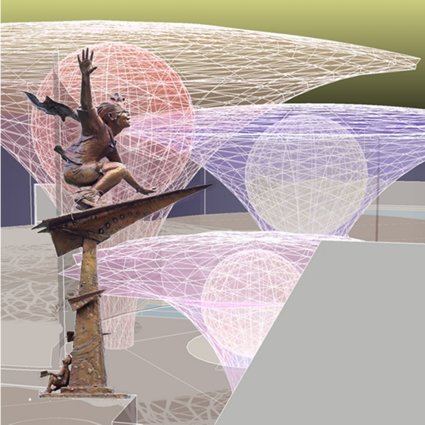Schematic
plan - February 15, 2004 - 3d Model |
| Matt
Fulvio and Scott Arenz built this 3d software Model
of the Master’s NavCenter in early February over
a 10 day period. It was developed directly from my
hand drawn Notebook sketches and computer-drawn schematic
Floor Plans [link].
As this work was done, we used the exercise to dialog
on many aspects of the design and, of course, the
software allowed us to explore the concept in detail.
While there remain some anomalies, that were not
worth the time to work out, it is clear from this
experience
that this concept can work. We are, in actuality,
somewhere between Schematic and Preliminary in its
development.
Recently
at Master’s, following the development of the
Model, the D/B/U Team set metrics in terms of costs
and time-to-build
that
will
form
the
basis
of
our design development. We decided to pursue this design
until we learn how to build it or a better one evolves
out of the process. As has been noted elsewhere [link],
this work deliberately pushes the state-of-the-art
in many areas. It has to in order to fulfill its mission
and be the appropriate [link] expression
of the aspirations of the Master’s community.
The task ahead is not to design and build what we know (at
this time) we can accomplish and afford. No, the task
is to learn how
to build what in fact we need, what expresses
our journey ahead, and what develops our ability and
capacity to
accomplish the even greater challenges of the future.
The masthead of this piece is made up of two elements:
a statue by Gary Lee Price [link],
which
expresses the vision of Master’s of their
students as master-learners who can accomplish
everything in life that they set out to do. This image
is superimposed of an image of the NavCenter which
is our promise to ourselves and the students that we
will ask nothing of them that we do not demand of ourselves.
The purpose of any NavCenter is to provide the place,
tools and processes that facilitate (to make easy)
the achievement of a communitie’s highest aspirations.
It is always true, of course, but in this work it is
a
critical
foundation of our process ahead: the means and
the
ends have to be tightly integrated; the connection
between them made explicit; the spirit of the enterprise
must (and, of course always does!) be embedded into
every aspect of the journey. Frank Lloyd Wright expressed
it this way: what a man does, that he is.
What we build and how we build it is what
our children will learn. The aspirations we
set for ourselves will guide them as they choose their
own quests. |
During
Wednesday the 11th through Friday the 13th of February,
the concept was shared by me with a variety of Master’s
ValueWeb [link] members:
administration, teachers, board members, architects,
builders, and so on. We explored the idea from the
standpoints of build-ability, costs, public impact,
schedule, relationship to the future new Master’s
Campus (thus
the “exit strategy” from this property)
and how the design captures the energy, spirit and
intent
of Master’s Academy. In doing this, we initiated
the formation of the Design/Build/Use Team that will
fulfill this dream. Notably absent from this dialog
were local community groups and the children themselves.
This visit was possible because it was a school break
for staff development days. With the next visit,
the interaction will expand to community and to the
children who are, of course, the ultimate users.
participating in this adventure and its continuation
to the new
campus will be made part of the student’s daily
life and curriculum.
Master’s
does not present itself as a
religious school. It is explicitly based on Christian
values
and metaphysical
orientation.
These are not pushed nor are they expressed in a dogmatic
way - as is so often the case with many educational
institutions based on specific religious, philosophical
or scientific
contexts. A wide range of perspectives are not programmed
out of the intellectual life of the teachers and students.
This is not a place that teaches exclusion or being
against - it is a place that is focused on a vision
that it is for and intent on bringing that
vision into reality. The Master’s values simply are the
foundation by which life is lived in this environment.
Like any authentic
[link] work
of architecture, these values must be embedded into
every aspect of the design, organically, as are those
aspects related to the times, the place and the future
that this community wishes to build. In this
sense, this piece of architecture is like a
church even though it is not a church. It
is, perhaps, more church-like
than many modern churches that seem to be some combination
of shopping center, airport and country club rather
than a place of contemplation. In Hebrew, “to
worship” means to work for; the root
of the word “religion” means to connect
back (to).
The NavCenter has to “connect back” as it “works” to
create a new future. |
|
|
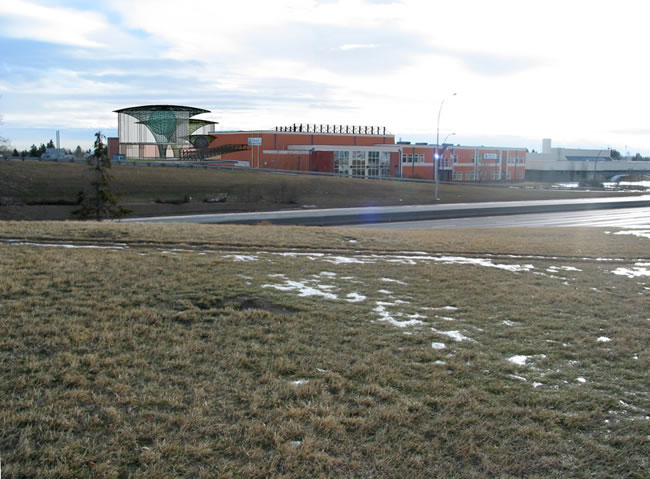 |
View
from the West looking across the highway:
| The
North side (from East to west) is most
exposed view into the NavCenter while the
other sides are more “contained” by
the existing buildings. This works well for
several reasons.
North light is the greatest unobstructed
source into the complex. South light will
be filtered by the various “Tree” tops.
East and West light is available for controlled
solar gain at different times of the day.
The NavCenter, besides being a place in which
to create the future Master’s Academy, deliberately
“drives a stake into the ground” by declaring,
by example, just what the essence of that
future is intended to be. This is ”not your
father’s school” and there is no making a
mistake about it. This design declares to
the world an intent that there is no backing
away - compromise is driven
out of possibility; the challenge remains. |
|
|
|
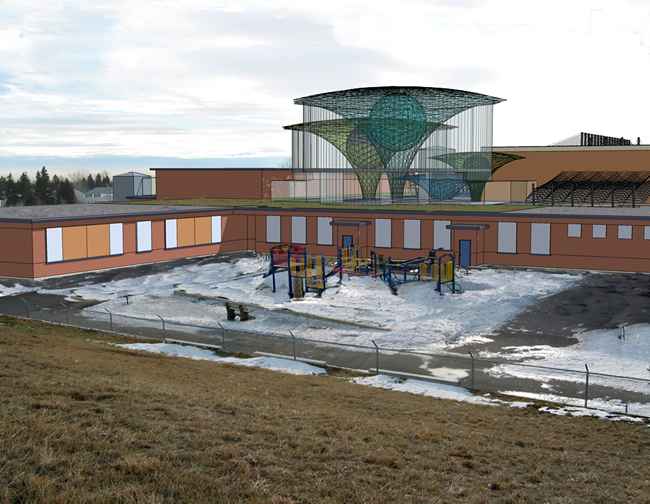 |
View
from the North from access road:
| In
these “shots,” the model is superimposed
over the existing structure and grounds.
The existing building and landscape have
been left as they presently are. Of course,
in reality,
this will
not
be the case and care will be taken to
alter both existing structures and landscape
as is appropriate. The extent that this
will be done is a factor of time, budget
and program which will be determined
by the “exit strategy” from the property
when master’s moves to the new campus.
If the move is accelerated and/or the
existing school is sold to a church or
school, the modifications to the existing
structures will be relatively modest.
If the move is delayed and/or the property
is transformed into an Incubator, Office
Hotelling Environment and commercial
NavCenter the modifications will be relatively
extensive. The profit created from this
phase of the project will be reinvested
in the New Campus. |
|
|
|
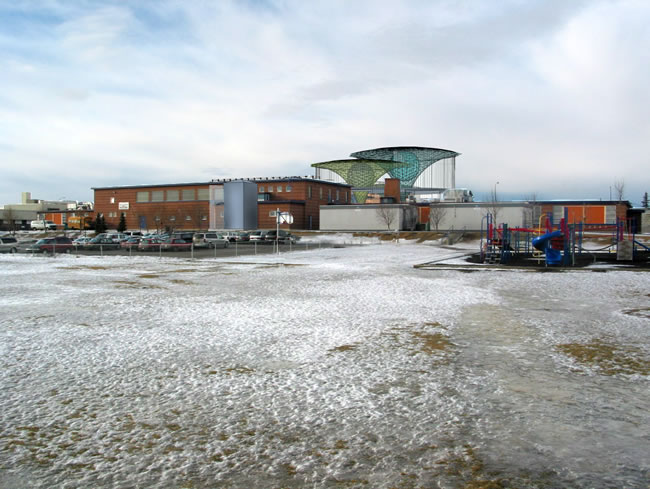 |
View
from the East:
| The
space, on the right of the new Elevator/Stairway
tower, now occupied by temporary building
is a prime candidate for future development.
There are several opportunities
for the expansion of both recreational
and office-learning spaces on the existing
plot, as well as, for expanded
parking. this work can be done with little
loss of open grounds or negative impacts.
The existing facility can easily be turned
into a world-class conference facility
of 3,000 persons - modest in size but
high in amenity and functionality.This
may well turn out to be the best use
after Master’s moves.
There are, of course, community and traffic
issues that will have to be dealt with.
The strategy is to design with the outcome
use to remain as a school;
and, to demonstrate, by experience, the
potential value to the surrounding community
associations. |
|
|
|
Various
Model Views and Notes |
View
Looking Down:
| The
suspended Courtyard cover has been partially
removed to show the structures below.
This view illustrates the roof plan view.
North is at the top, the
grammar school on the right and the high
school on the left. At present, the area
in between existing structures is not
used. This area will become an
enclosed
landscape
with the NavCenter rising out of it supported
by four tree-like geodesic-like structures
that are “planted” in the “L” of the
Courtyard. |
|
|
|
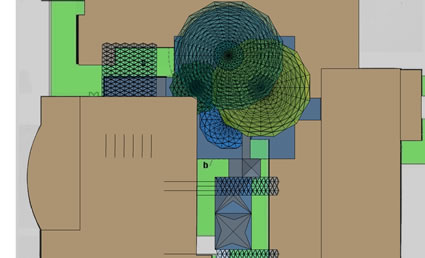 |
View
Looking North West - Bird’s Eye From Parking/Entry:
| This
illustrates the extensive amount of roof
landscaping surrounding the 2nd Floor.
It also shows the relative size and height
of the four structural
“Trees.” The basic circulation strategy
of the layout can also be seen providing
the NavCenter access
and egress from all four points of
the compass with the West
and
South
providing the main entries. In this way,
the entire school “engages” with the
NavCenter which, literally, sits at the
heart. |
|
|
|
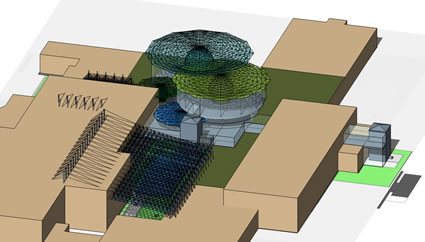 |
View
Looking North from Existing Roof Deck:
| The
second floor of the NavCenter is level
to the existing roof area of the grammar
school; it spills out onto the roof
as required and provides access to extensive
roof landscaped areas. This view show
the covered Courtyard (to the left) with
the opening roof tops of the Multipurpose
rooms, the Elevator/Stairway tower and
trees
#3 & #4 in the background. |
|
|
|
 |
View
Looking West From Over Grammar School Gym Roof Top:
| The
full scope of the 3rd Floor can be seen
from this viewpoint; it is suspended
from Trees #3 & #4. The second floor
extends past the third floor line in
several places creating a flat glass-roofed
“box” that extends out onto the existing
roof deck. The wire
suspended glass roof over the Courtyards
is “held back” and connected to the NavCenter
with similar flat roof panels. |
|
|
|
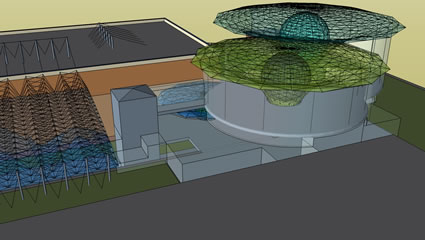 |
View
From 2nd Floor Up to 3rd Floor Looking West to the Mountains:
| The
Model, as represented here, shows the
basic structure and shell of the building.
It does not indicate the finished interior
with Armature [link],
WorkFurniture [link] and
the full range of materials and finishes.
A sense of how these component might
be formed can be imagined by looking
at the VA Salt lake City NavCenter [link] and
the VCH Executive Offices [link] projects. |
|
|
|
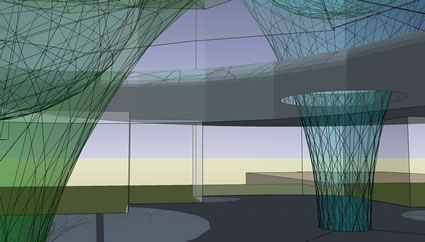 |
View
Looking South Into Covered Courtyard:
| Tree
#1 is overhead and the existing High
school Gym to the right. The Multipurpose
Rooms
in the covered landscaped Courtyard have
roof “peddles” that open
to the protected landscape. The Courtyard
is conditioned
to stay within a 40 to 90 degree temperature
range. The existing classrooms and new
NavCenter spaces can open to and
be shut off from it as required. |
|
|
|
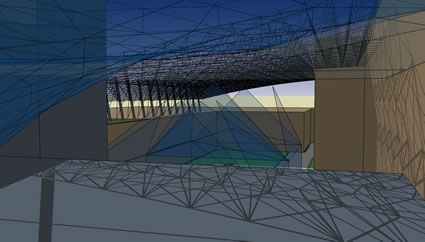 |
View
Looking South:
| The
vertical scale is emphasized in the NavCenter.
This is necessary to get the spaces up
into the light, to make them “read” from
around the building and to provide a
long viewpoint and horizon for the 2nd
and 3rd floors as is appropriate to
their function. Symbolically, the NavCenter
is the future rising out of the industrial
past. |
|
|
|
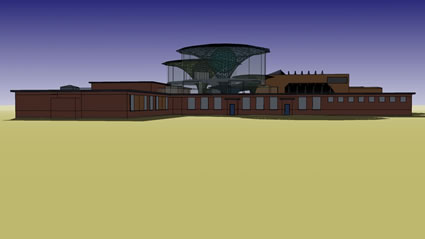 |
View
Looking West at New Entry and Elevator/Stairway:
| From
the parking area, Trees #3 and #4 just
barely show over the existing buildings.
The new Entry, Stair and elevator core
components will provide a great deal
more focus, utility and ceremony to the
existing children’s drop-off and pick
up area which lacks adequate amenity
and security. The elevator will allow
entry to the NavCenter independent of
the school when required. |
|
|
|
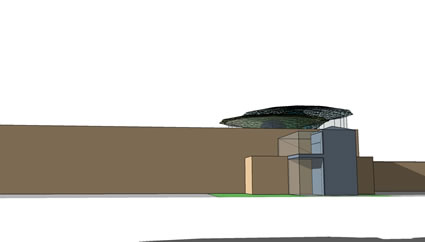 |
View
Looking North East - Bird’s Eye From Above Highway:
| The
NavCenter is about 15% of the total mass
of the complex; it completes and augments
what is already there bringing it into
a fuller expression of the building’s
function. Enlarging some exiting windows
into glass doors, removing selective
walls, adding skylights, landscaping,
casework, WorkWalls and artwork will
complete the transformation of the whole. |
|
|
|
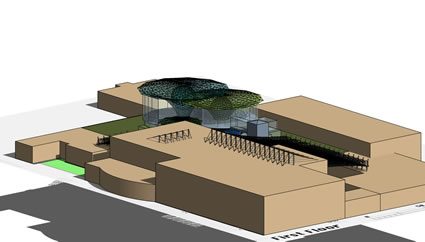 |
View
From High School GYM (with Gym removed from the perspective):
| This
perspective shows the various floor
levels interacting creating a total
of 8 different levels. Prospect and refuge
are afforded. Sub-spaces
are created by different ceiling
heights, and the areas formed by vertical
openings. A high variety of views, some
into courtyards, some on to roof decks,
some to the mountains, are provided each
appropriate for the adjacent function. |
|
|
|
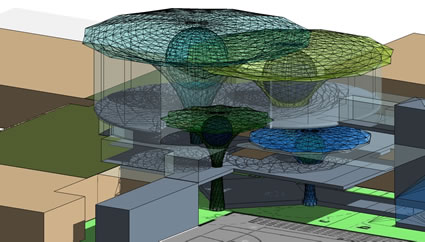 |
View
Moving Closer Towards the Third Floor Area - Tree #4:
| The
3rd Floor is suspended from Trees # 3
and #4. In this view, it is possible
to see how the Tree Houses are positioned
in relationship to various internal areas
and to the outside; they make
a “room within a room” - self contained
yet capable of engagement with the activities
around them making up their landscape;
separation and integration are layered
and user controlled. |
|
|
|
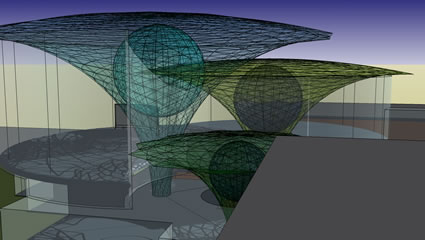 |
View
from Meditation Tree House to Group Interaction Tree House:
| In
Pattern Language [link] this
is a variation of the “Zen View” pattern.
The internal and external glass skins
are made up of transparent, translucent
and colored elements of various sizes
some of fixed, some operable. Combined
with screens of various materials and
patterns, this glazing becomes the means
to control sight, sound and temperature
between
areas. |
|
|
|
 |
| This
design is truly a cybernetic forest [link]. It is a tightly integrated organism. It is a series of
clustered, recursive shells each a complete system in itself,
each extending the function of the other - an integration
of process, tools and environment to support learning,
creativity and incubation. It is symbolic and fact-based,
a social statement and an efficient support system
for focused work activities. It employs mega-structure
strategies [link] on
an intimate scale. While unique, it represents a long history
of development with many antecedents [link].
To be accomplished, it requires the kind of effort
and performance that Master’s holds as its educational
ideal.
The process will be documented in the PLS system [link] and
the learning codified for use in building the new Master’s
Academy Campus. We are building a knowledge-base and a
ValueWeb [link] as
well as a structure. |
hidden_design_assumptions |
| The
flat-earth, low-variety box-like environments that make
up the typical place of learning do not contain within
themselves sufficient space, utility, expression and adaptability
to satisfy the requirements made necessary by the new world
of education and innovative workplace [link].
Nor do they inspire or instruct. The result of any educational
process is the
formation of citizens who will live and work in the future.
What kind of future
[link] are
we preparing our children for? What design assumptions [link] do
we hold about this future? How are we passing these assumptions
- known to us or “hidden” - on to ourselves and future
generations by the environments we build and the way [link] that
we build them? What are we teaching by our own
actions? What
limits [link] are
we setting? What kind of world do we
project? |
| Authentic
Architecture [link] must
be an appropriate expression of time, circumstance and
place. At the same time, it must
express universal values and timeless forms. If it does
not do this it fails as art [link] and
becomes merely a creature of utility. This will not do.
A great city is one you want to walk in. A great building
is one you want to touch, one that facilitates your many
tasks and moods, one that provides you new ways of seeing the
world and understanding your own place within it - a great
building transforms the context in which life is
practiced and therefore invites you to transform
your own sense of what and who your are. Because this work
is grounded in the past, the present and a possible future,
it can bring context to the transition that is taking place
in education and how Master’s is working to transform it.
One trans-forms things by first transforming self. |
|
posted:
February 14, 2004 • revised February 20, 2004 • copyright
© 2004 Matt Taylor |
|
|
| Return
To Master’s NavCenter |
|
|
|
|
|
| Return
To the New School Environment |
|
|
|
|
|
| Master’s
Academy - FutureSchool Project |
|
|
|
|
<script src="http://www.google-analytics.com/urchin.js" type="text/javascript">
</script>
<script type="text/javascript">
_uacct = "UA-1597180-1";
urchinTracker();
</script> |
|
